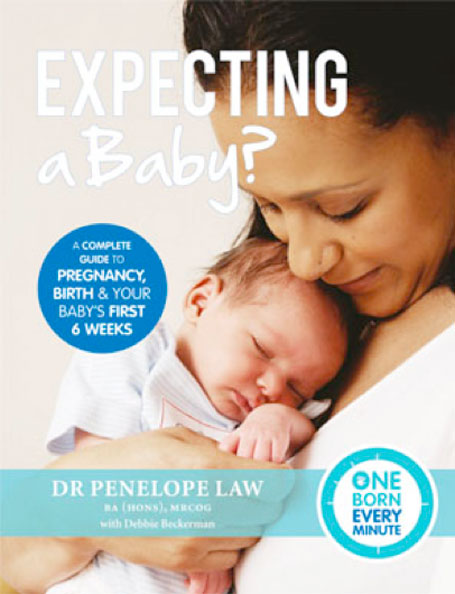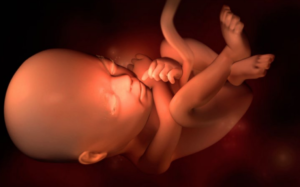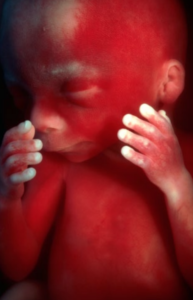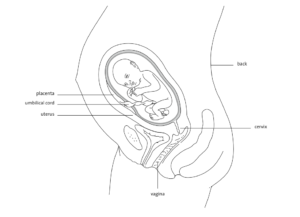Second Trimester

Your baby continues to grow fast, from a small fetus at the start of the trimester to a fully formed baby at the end of Week 26. You will start to feel your baby move at around the middle of the trimester and, as the baby increases in size and strength, these movements will become more vigorous and defined.
The second trimester is the time in pregnancy when most women feel at their best. The unpleasant early symptoms, such as tiredness and morning sickness, have usually disappeared; you are starting to look pregnant, but your bump is not so large that it hinders you; and you feel optimistic that your pregnancy is now ‘safe’, because the placenta rather than just the maternal hormones is now fully supporting the pregnancy.
Weeks 14-16
Your Baby
Week 14: Reflex muscular activity is occurring, although you will not yet feel your baby moving. The external genitalia have differentiated into male or female, allowing the sex of the fetus to be determined by ultrasound scan. Downy, colourless hair, called lanugo, starts to develop and now breaks through the skin on the eyebrows and upper lip. The lower limbs are fully formed and growing fast, and all limbs are more in proportion with the rest of the body. The central nervous system continues to develop during these early weeks of the second trimester, allowing or an increasingly wide range of movements. The fetus measures 80 mm crown to rump and weighs 45 g.
Week 15: This week sees the fetus making some rudimentary breathing movements. Limb movement is becoming more coordinated, although still cannot be felt. The fetus will even start to suck its thumb if the latter comes into contact with the mouth. This is not a conscious action, but merely an example of muscular activity. The pattern of hair on the scalp is determined.
Week 16: The fetal head, although still large, is proportionately less so than in Week 14 and the body has straightened out. In the male fetus, the penis and scrotum are now more clearly visible, while in the female, the uterus, Fallopian
tubes and vagina are beginning to form. Slow eye movement occurs and toenails are just starting to appear.
You
Significant changes to your body are taking place over the next few weeks:
- Many women experience a heightened sex drive in pregnancy, and especially in the second trimester when they are feeling at their best.
- The volume of red blood cells rises rapidly in the early weeks of this trimester to catch up with the increase in the blood’s water content that took place earlier on in your pregnancy.
- The amount of blood being pumped through the heart (your cardiac output) also increases during this time, though less so in the last few weeks of the trimester.
- The volume of blood pumped by the heart at every beat (your stroke volume) similarly increases.
- The blood vessels dilate (meaning that your ‘peripheral resistance’ decreases), thanks to the relaxing effect of progesterone. As a result, some women find that their blood pressure is actually lower at this stage than it was before they became pregnant.
- The heart increases slightly in size and pumps more powerfully, but not faster.
- At the start of the second trimester, 25 per cent of blood flow (five times more than when you are not pregnant) is directed to the uterus to support the growing fetus and placenta.
- A greater amount of blood than normal is also directed at your skin and mucous membranes.
- Your kidneys are filtering an extra half litre of blood every minute until the end of your pregnancy and their filtering capacity is around 60 per cent higher than normal.
IS SEX SAFE?
Some couples worry that sexual intercourse could potentially damage their unborn baby or in some way threaten the pregnancy, especially during the first trimester when the risk of miscarriage is greatest. Babies are well-cushioned by amniotic fluid, and will not be harmed by penetrative sex. Unless you have a history of miscarriage or are experiencing some unexplained first-trimester bleeding, it is perfectly safe to have sex at this time, as there is no link at all between intercourse and an increased chance of miscarriage. Indeed, if yours is a normal pregnancy, it is safe to continue having sex until your membranes rupture (or ‘waters break’). This is because, until this time, the baby is protected by a cervical plug of mucus, which seals off the uterus from bacteria, and is also cushioned by amniotic fluid.
Fears that intercourse in later pregnancy can trigger premature labour are unfounded. While it is true that semen contains prostaglandins and that artificial prostaglandins are used to ripen the cervix when labour is induced, semen alone cannot trigger labour unless the cervix is ready to start dilating (usually at term). However, you may be advised to avoid sexual intercourse if:
- you have had previous premature labours (in case your cervix has already started to dilate)
- you have threatened premature labour
- you are bleeding (until you have seen your obstetrician and been reassured that all is well)
- an internal examination has revealed that your cervix is shortened or slightly dilated
- you have placenta praevia (see box above).
Weeks 17-20
Your Baby
Week 17: The digestive system and lungs are developed and are starting to mature, as is the nervous system. A layer of fat, called myelin, coats the nerves in the spinal cord that link the fetal muscles to the brain. Your baby’s eyes are now further towards the front of the face and, at this stage of gestation, the head makes up just under a third of the total body length of 15 cm.
Week 18: Ossification continues and bones are clearly visible, with the legs catching up with the development of the arms. The formation of the facial bones is complete and the nose is more prominent. The external ears are in their final position on the side of the head, and the tiny bones of the inner ear have hardened, enabling the fetus to be aware of sounds. Consequently, the face appears increasingly recognisable and the features more delicate. In the female fetus, ovaries have formed. Fetal movements are becoming more extensive.
Week 19: The fetus begins to develop a thin layer of subcutaneous white fat, while small amounts of insulating brown fat are also formed and deposited at the nape of the neck, around the kidneys and behind the breastbone. This is essential for body warmth, which is why very premature babies, who have insufficient brown fat, find it very difficult to keep themselves warm.
Week 20: Instead of the rapid growth of the previous weeks, development is concentrated on internal organs, such as the lungs and digestive system, as well as the immune and central nervous systems. Bones are thickening as calcium continues to be deposited on the skeletal structure, and the spinal cord is developing a fibrous sheath around the nerve bundles, which will protect them from any possible future damage.
You
Week 17: Hypertension (high blood pressure) sometimes occurs in the second trimester, particularly if you are overweight, over 40 or have diabetes. While hypertension can be problematic for the pregnancy in itself, it is also an indicator, later in pregnancy, of the serious condition of pre-eclampsia.
Week 18: This is the time when the fetal movements (known as ‘quickening’) can first be felt, although first-time mothers may not be aware of these until Week 20. It may feel like an odd, ‘fluttering’ sensation deep inside your abdomen, and
is often mistaken for wind.
Week 19: You probably experienced some minor abdominal aches and pains in the first trimester, as the ligaments in the pelvic area were adjusting to the pregnancy. These can continue throughout the second trimester, but if you experience any sudden pain, contact your GP or midwife.
Week 20: You are now halfway through your pregnancy! Your heart is pumping 7 litres per minute round your body and you will almost certainly look pregnant to others by now. While you generally feel very well by this stage, some women are still suffering from morning sickness, while others can develop temporary but painful conditions such as carpal tunnel syndrome. If you have not already started feeling your baby move, you may do so around this time.
Weeks 21-24
Your Baby
Week 21: The foetal measures around 18 cm (about half that of a newborn baby) and the weight is approximately 450 g, although genetic characteristics inherited from you and the father now mean that size and weight will vary a little from one baby to another.
Week 22: The fetus’ face is fully defined and lips and head hair, as well as eyebrows and eyelashes, become visible. The testes in a male fetus start to descend, but they will not emerge from the abdominal cavity until much later in the pregnancy or even after the birth. The fingers and toes are fully formed and the hands will grasp at anything they come into contact with, such as the umbilical cord. The fetus can hear the maternal blood flow and heartbeat, as well as intestinal rumblings and external loud noises.
Week 23: The next month of gestation sees rapid weight gain, although the body is still lean (see picture). The skin is wrinkled and translucent, seeming pinkish red because the blood is visible in the capillaries. Rapid eye movements begin. As the brain matures, the fetal brainwaves become similar to those of a newborn baby and can be monitored on an EEG (electroencephalogram).
Week 24: All the major organs are now developed. The skin is still wrinkly, but as layers of fat continue to be deposited, it gradually becomes less translucent and more reddish in colour over the next few weeks. The eyelids have partially opened, creases on the palms of the hand are forming and the fetal movements can be felt, both by you and by someone else when they place their hand on your abdomen.
You
Week 21: By this week, the fundus will have just reached your navel. Hormonal changes that occurred from the start of pregnancy can make your skin very dry and itchy, so make sure you use a good moisturiser (it doesn’t really matter which one, as long as you apply plenty of it).
Week 22: The pigmentation of your nipples, areolae, genitalia and moles also increases and by this week they have usually darkened; a dark line, called a linea nigra, running down the middle of your abdomen may also be noticeable. That said, if you have archetypal English fair skin with freckles, don’t be disappointed or worried if you don’t see one: your pregnancy is still fine!
Week 23: If you are feeling fit and well and there are no complications with your pregnancy (which may require you to attend hospital appointments), now is a good time to plan either a short break or longer holiday. It will possibly be the last time for a while that you will be able to indulge in a little ‘me time’, so enjoy yourself!
Week 24: By this time, you will probably start to get a sense of when and how much your baby moves in any given day, and whether the movements increase if, for example, you are lying down or exercising. If you have not felt your baby move at all by this stage, contact your midwife without delay, as she will check the baby’s heartbeat. If necessary, further ultrasound testing can be arranged.
Weeks 25-26
Your Baby
Week 25: Your baby’s face is becoming ever more defined. A colour 3-D (or 4-D) ultrasound scan towards the end of the second trimester can give a very clear image of your baby’s face, but bear in mind that most fetuses look very similar at this point in their gestation, so it will be difficult to pick out any familial characteristics.
Week 26: By the end of the second trimester, the fetus measures 23 cm and weighs around 800 g. Fingernails are growing and its body is still lean. The adrenal gland, which is situated just above the kidney, plays a key role in hormone production during gestation and during the third trimester produces large amounts of androgen-like hormones (which, in female fetuses, are converted to oestrogen). As a result, it is disproportionately large: by Week 20, the adrenal gland is as large as the kidney (although it is not always visible on an ultrasound scan) and, by Week 30, has a relative size that is ten to twenty times
larger than that of the adult adrenal gland. The thyroid gland is the first endocrine gland to appear, and it reaches structural maturity by Week 17.
You
Week 25: Back pain can become a problem and you need to take care of your posture when sitting and standing, as well as finding ways to safely bend down and pick things up.
Week 26: While you will only put on a little weight during the first trimester, in the second trimester you will be gaining about 0.5 kg per week, so that by the end, you will be around 6–6.5 kg heavier. If you have gained much more or much less than this, your GP or midwife may bring this to your attention at your antenatal checks.



